The Blaze Star, T Coronae Borealis (T CrB), is a binary star system located 2,630 light-years away in the constellation Corona Borealis (the Northern Crown). The star system normally shines at magnitude 10 and is invisible to the unaided eye.
However, the faint star is classified as a recurrent nova and experiences outbursts during which it can become as bright as magnitude 2.0. One such outburst is expected to occur in 2024 and it will be a once-in-a-lifetime event. It may be visible without binoculars for several days or even a week. After the nova event, the star will dim again below unaided eye visibility and stay quiescent for another 80 years.
Star system
T Coronae Borealis is a binary system that consists of an evolved red giant star of the spectral type M3III+p and a white dwarf companion. The red giant has a mass of 1.12 solar masses and has expanded to a size of 75 solar radii. With an effective temperature of 3,600 K, it is 655 times more luminous than the Sun.
The hotter component, the white dwarf, has a mass of 1.37 solar masses and is about 100 times more luminous than the Sun.
The two components have an orbital period of 227.55 days and are separated by only 0.54 astronomical units (54% of the distance between the Earth and the Sun).
Because the two stars are in a very close orbit, the red giant transfers material onto the white dwarf. The dim stellar remnant is surrounded by a thick cloud of accumulated material from its giant companion star and it has an accretion disk embedded in the cloud.
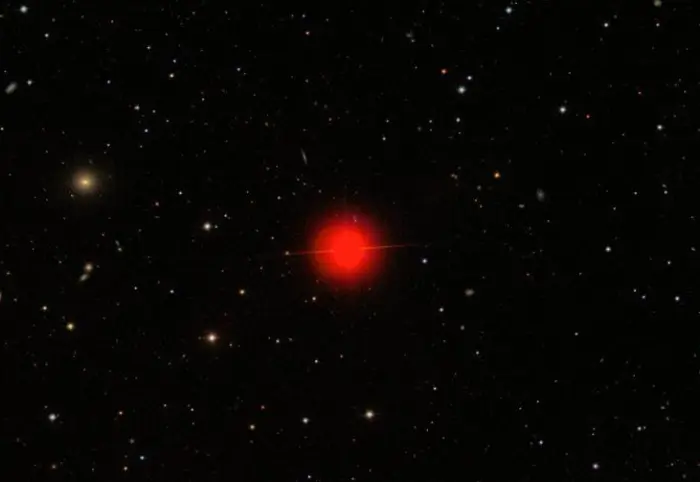
T Coronae Borealis (Blaze Star), image: Wikisky (SDSS2)
T Coronae Borealis normally shines at magnitude 10, but it has been observed to reach magnitude 2.0 during outbursts. When T CrB is in its quiescent state, the red giant dominates the spectrum in visible light, while the white dwarf star dominates the output in the ultraviolet part of the spectrum.
When the star system is experiencing an outburst, the white dwarf expands due to an increased transfer of material, which in turn increases the total luminosity of the system.
On May 12, 1866, T Coronae Borealis reached a visual magnitude of 2.0 during an outburst and, on February 9, 1946, it shone at magnitude 3.0. During these events, it was catalogued as NOVA CrB 1866 and NOVA CrB 1946.
Novae are transient astronomical events that cause the sudden brightening of a star system. Ancient and medieval astronomers interpreted these cosmic events as the appearance of a “new” star. (Nova means “new” in Latin.) Novae were often called “guest stars.”
All known novae have been observed in close binary stars in which one of the components is an accreting white dwarf. As the white dwarf heats the hydrogen accreted from the companion, the accumulated material reaches a critical temperature, triggering runaway fusion. In the case of recurrent novae like T Coronae Borealis, the white dwarf expels its atmosphere and the red giant star continues to feed its companion after each eruption.
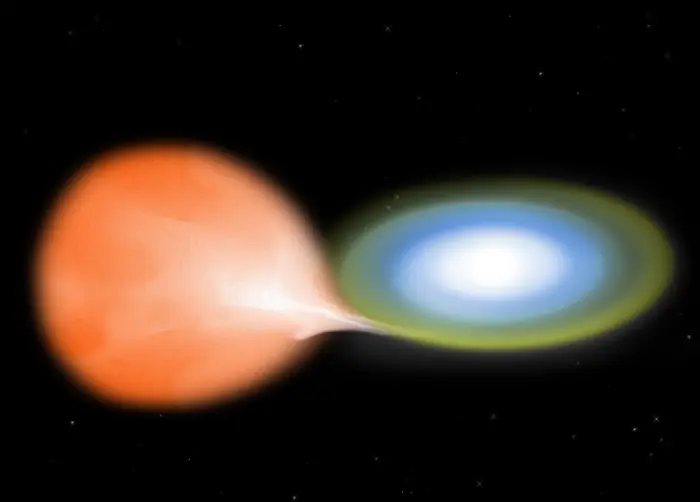
The artist’s illustration depicts a classical nova binary system just before an eruption on the surface of the white dwarf. Classical novas occur in a system where a white dwarf closely orbits a normal, companion star. In this illustration, gas is flowing from the large red,companion star into a disk and then onto the white dwarf that is hidden inside the white area. As the gas flows ever closer to the white dwarf, it gets increasingly hotter, as indicated by the change in colors from yellow to white. When the eruption occurs, it engulfs the disk of gas and the red companion star. Image credit: NASA/CXC/M.Weiss (PD)
However, if the white dwarf ever accretes the critical mass of 1.44 solar masses (the Chandrasekhar mass), it can reignite and possibly trigger a type Ia supernova event. The supernova would completely destroy the white dwarf and, while it would not affect Earth, it would appear bright enough to cast shadows.
The T Coronae Borealis system was observed to be brightening in February 2015, going from magnitude 10.5 to 9.2. In mid-2023, the brightness dropped by about 0.35 magnitudes. Scientists expect the dimming to be followed by another nova eruption before September 2024.
The star has an 80-year cycle during which it is stable and then gets brighter before experiencing a pre-eruption dip in brightness. The dimming is usually followed by a large outburst about 11 months later.
The T CrB nova is expected to be as bright as magnitude 2.0, which is comparable to the brightness of Polaris (the North Star) and slightly brighter than Alphecca, the brightest star in the Northern Crown.
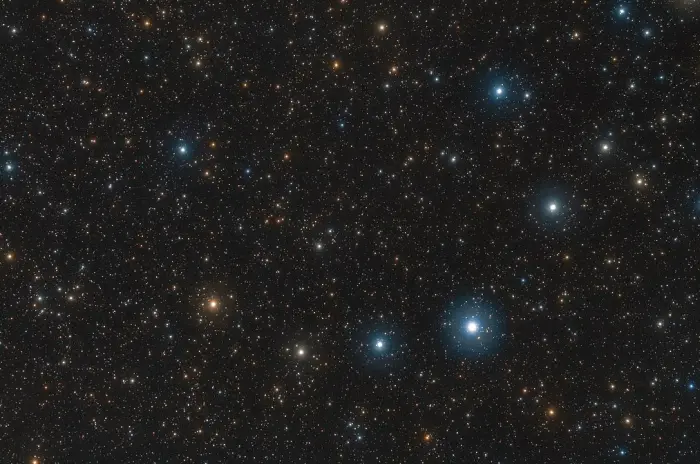
The Corona Borealis constellation, image credit: Alexander Kurilov (CC BY 4.0)
Facts
T Coronae Borealis was discovered by the Irish astronomer John Birmingham during an outburst in 1866. It was previously observed as a 10th magnitude star by the German astronomer Friedrich Wilhelm Argelander, who catalogued it as BD+26° 2765 in his Bonner Durchmusterung (BD) star catalogue, published in Germany from 1859 to 1863.
The first record of a T CrB nova comes from the German priest and chronicler Burchard of Ursperg, who described “a faint star that for a time shone with great light” in 1217.
T Coronae Borealis is one of the few recurring novae visible to the unaided eye. Others include RS Ophiuchi in the constellation Ophiuchus, which peaks at magnitude 5, and T Pyxidis in Pyxis, which shines at magnitude 6.4 at maximum. RS Ophiuchi has a cycle of 9 – 26 years and T Pyxidis, 12 – 44 years.
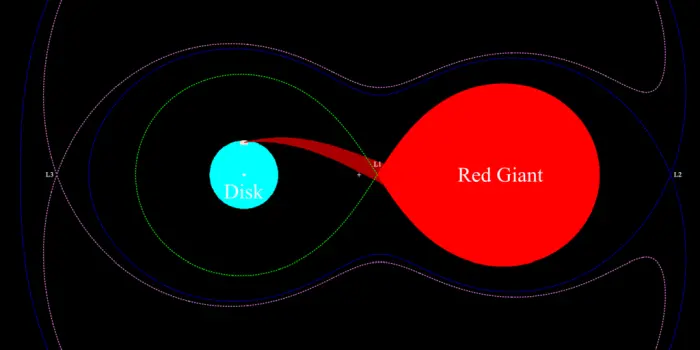
Illustration of T Coronae Borealis showing the Roche lobe, overflow stream, and accretion disk based on Kraft1958 with Stanishev2004 mass ratio. Image credit: Wikimedia Commons/Steven L. Allen (CC BY-SA 4.0)
Name
T Coronae Borealis does not have a proper name formally approved by the International Astronomical Union (IAU). It has been nicknamed the Blaze Star because it can dramatically increase in brightness during eruptions.
The star is commonly referred to by its variable star designation T Coronae Borealis. It is also catalogued as HD 143454 in the Henry Draper Catalogue, HR 5958 in the Yale Catalogue of Bright Stars, HIP 78322 in the Hipparcos Catalogue, and SAO 84129 in the Smithsonian Astrophysical Observatory Star Catalog.
Location
T Coronae Borealis appears next to the semi-circle of stars that form the celestial Northern Crown (the Crown of Ariadne). The constellation figure of Corona Borealis appears between two relatively bright asterisms, the Kite in Boötes (the Herdsman) and the Keystone in the Hercules constellation. The Keystone and the Northern Crown appear in the region between the bright Vega in the constellation Lyra and Arcturus in Boötes.
Arcturus, the bright star at the base of the Kite, can be found by following the arc of the Big Dipper’s handle, formed by Alioth, Mizar, and Alkaid. The Keystone appears near Vega. The Corona Borealis constellation is easy to spot between the Keystone and the Kite on a clear night.
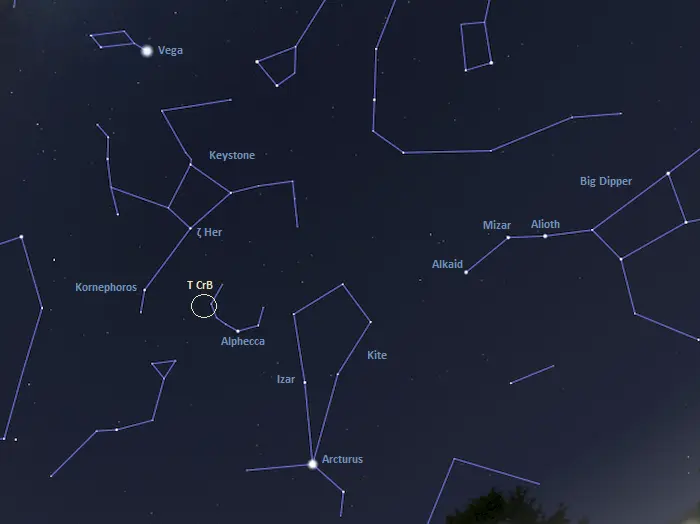
The location of T Coronae Borealis, image: Stellarium
Alphecca, the brightest star in Corona Borealis, marks the jewel in the crown. The star was traditionally also known as Gemma. It is the brightest star in the semi-circle also formed by Nusakan (Beta CrB), Theta CrB, Gamma CrB, Delta CrB, Epsilon CrB, and Iota CrB. T Coronae Borealis appears close to Epsilon CrB, which shines at magnitude 4.14 and is visible in good conditions.
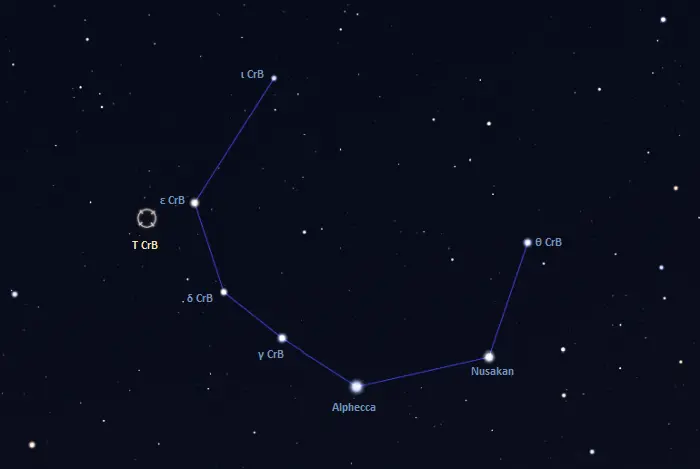
T Coronae Borealis location, image: Stellarium
Constellation
T Coronae Borealis is located in the constellation Corona Borealis. The Northern Crown is one of the 48 Greek constellations, catalogued by the Greco-Roman astronomer Claudius Ptolemy of Alexandria in his Almagest in the 2nd century CE.
In Greek mythology, the constellation is associated with the crown of Ariadne. According to Greek legend, the god Dionysus gave the crown to his bride, the Cretan princess Ariadne, and later threw it into the sky, where it became the constellation Corona Borealis.
The Northern Crown occupies only 179 square degrees of the northern sky and is the 73rd largest constellation out of 88. It is slightly brighter and larger than its southern counterpart, Corona Australis (the Southern Crown), which lies next to the brighter Sagittarius. Despite its size, Corona Borealis is one of the most distinctive northern constellations, easily spotted from areas without too much light pollution.
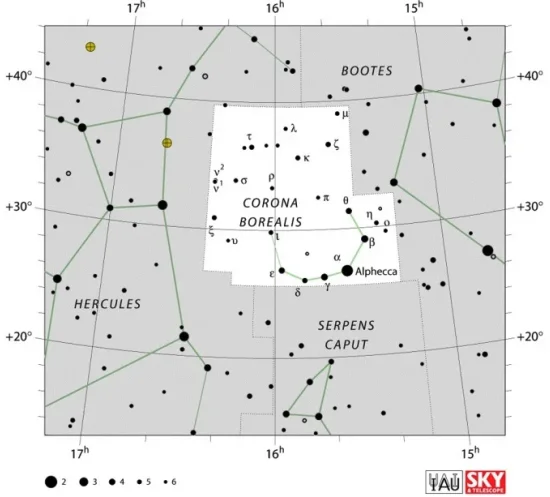
Corona Borealis constellation map by IAU and Sky&Telescope magazine (CC BY 4.0)
Corona Borealis contains only one star brighter than magnitude 3.0, the eclipsing binary star Alpha Coronae Borealis (Alphecca). Other notable stars in the constellation include the binary stars Nusakan (Beta Coronae Borealis), Gamma Coronae Borealis, and Theta Coronae Borealis, the orange giant Epsilon Coronae Borealis, which hosts an exoplanet, the variable yellow giant Delta Coronae Borealis, the Mira-type variables S Coronae Borealis, V Coronae Borealis, and W Coronae Borealis, and the Sun-like yellow dwarf Rho Coronae Borealis, which is orbited by four planets.
The constellation is also home to R Coronae Borealis, a yellow supergiant that serves as a prototype for a class of stars known as the R Coronae Borealis variables. The star is popularly known as the Fade-Out Star or the “reverse nova.” Its brightness occasionally drops from magnitude 6 to magnitude 15 for periods of months to years.
Corona Borealis does not contain any bright deep sky objects visible in small telescopes. It hosts the spiral galaxy NGC 6085 (mag. 14.5), the elliptical galaxy NGC 6086 (mag. 12.7) – both members of the X-ray luminous cluster of galaxies Abell 2162 – as well as the spiral galaxies NGC 6122 (mag. 14.6), NGC 6120 (mag. 14.3) and IC 4539 (mag. 16.3), and the interacting pair IC 1166.
The constellation is home to several galaxy clusters that make up the Corona Borealis Supercluster, the most prominent supercluster in the northern celestial hemisphere.
The best time of the year to observe the stars and deep sky objects in Corona Borealis is during the month of July, when the constellation climbs higher above the horizon in the early evening. The entire constellation is visible from locations between the latitudes +90° and -50°.
The 10 brightest stars in Corona Borealis are Alphecca (Alpha CrB, mag. 2.23), Nusakan (Beta CrB, mag. 3.65 – 3.72), Gamma Coronae Borealis (mag. 3.83), Theta Coronae Borealis (mag. 4.13), Epsilon Coronae Borealis (mag. 4.13), Delta Coronae Borealis (mag. 4.57 – 4.69), Zeta Coronae Borealis (mag. 4.64), Tau Coronae Borealis (mag. 4.76), Kappa Coronae Borealis (mag. 4.79), and Xi Coronae Borealis (mag. 4.85).
T Coronae Borealis
| Spectral class | M3III+p |
| Variable type | Recurrent nova |
| Apparent magnitude | 2.0–10.8 |
| Distance | 2,630 light-years (806 parsecs) |
| Parallax | 1.092 ± 0.0275 mas |
| Radial velocity | −27.79 km/s |
| Proper motion | RA: −4.461 ± 0.016 mas/yr |
| Dec.: 12.016 ± 0.028 mas/yr | |
| Mass | 1.12 M☉, 1.37 M☉ |
| Luminosity | 655 L☉, ~100 L☉ |
| Radius | 75 R☉ |
| Temperature | 3,600 K |
| Surface gravity | 2.0 cgs |
| Constellation | Corona Borealis |
| Right ascension | 15h 59m 30.1622265912s |
| Declination | 25° 55′ 12.613382940″ |
| Names and designations | T Coronae Borealis, T CrB, Blaze Star, HD 143454, HR 5958, HIP 78322, SAO 84129, BD+26° 2765, AG+26 1536, NOVA CrB 1866, NOVA CrB 1946, PPM 104498, GC 21491, GCRV 9203, GSC 02037-01144, SBC7 558, TIC 462607643, SWIFT J1559.5+2553, SWIFT J1559.6+2554, 1SWASP J155930.15+255512.5, PBC J1559.4+2556, WEB 13243, AAVSO 1555+26, UCAC4 580-052260, IRAS 15574+2603, 2MASS J15593015+2555126, MWC 413, WISEA J155930.14+255512.6, WISE J155930.15+255512.7, TYC 2037-1144-1, DO 15377, Gaia DR1 1220110701675511040, Gaia DR2 1220110705972528512, Gaia DR3 1220110705972528512, CCDM J15595+2555AB, IDS 15553+2612 AB, WDS J15595+2555AB |